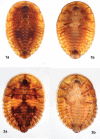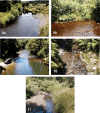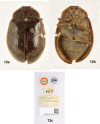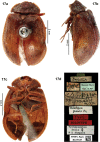A revision of the Chilean water penny genus Tychepsephus Waterhouse, 1876 (Coleoptera, Psephenidae, Eubriinae), with description of a second species and two larval morphotypes, and notes on other Chilean Psephenidae
- PMID: 37273973
- PMCID: PMC10238915
- DOI: 10.3897/zookeys.1164.103184
A revision of the Chilean water penny genus Tychepsephus Waterhouse, 1876 (Coleoptera, Psephenidae, Eubriinae), with description of a second species and two larval morphotypes, and notes on other Chilean Psephenidae
Abstract
The Chilean water penny genus Tychepsephus Waterhouse, 1876 is revised, with descriptions and photographic illustrations of life stages including two larval morphotypes, the pupa of one morphotype, and adults of two species. The pupa of Tychepsephus has not been reported previously. Tychepsephuscekalovicisp. nov. is described, and Ectopria (Chilectopria) grandis Pic, 1947, syn. nov. is proposed as a new synonym of Tychepsephusfelix Waterhouse, 1876, which is redescribed. Taxonomic treatment of the adults of both species includes images of the habitus of males and females, morphological variation, and male and female genitalia. Males and females are sexually dimorphic. Information on the habitat of Tychepsephus is provided and illustrated with photographs, and the known geographic distribution of the two species is mapped. The occurrence of Tychepsephus in Argentina is reported; therefore, the genus no longer can be considered endemic to Chile. The taxonomic status and geographic distribution in South America of other species of Psephenidae, particularly members of the subfamily Eubriinae, is reviewed.
Keywords: Aquatic beetles; South America; biology; distribution; habitat; life stages; neotropical; sexual dimorphism; synonym.
William D. Shepard, Cheryl B. Barr.
Figures














References
-
- Artigas J. (1963) Descripción de la larva de un psephenido Chileno (Coleoptera – Psephenidae). Gayana (Concepción) 1963(8): 3–11.
-
- Ashworth AC, Hoganson JW. (1987) Coleoptera bioassociations along an elevational gradient in the Lake Region of southern Chile, and comments on the postglacial development of the fauna. Annals of the Entomological Society of America 80(6): 865–895. 10.1093/aesa/80.6.865 - DOI
-
- Barr CB, Shepard WD. (2017) Eubriamesoamericana Barr and Shepard (Coleoptera: Psephenidae: Eubriinae), a new psephenid species from Central America with an enigmatic generic distribution. Coleopterists Bulletin 71(3): 437–444. 10.1649/0010-065X-71.3.437 - DOI
-
- Blackwelder RE. (1944) Checklist of the Coleopterous Insects of Mexico, Central America, the West Indies, and South America. Part 2. Bulletin of the United States National Museum 185. United States Government Printing Office, Washington, D. C., 189–341. 10.5479/si.03629236.185.2 - DOI
-
- Brown HP. (1983) A Catalog of the Coleoptera of America North of Mexico. Family Psephenidae. United States Printing Office, Washington, D. C., 8 pp.
LinkOut - more resources
Full Text Sources
Miscellaneous
